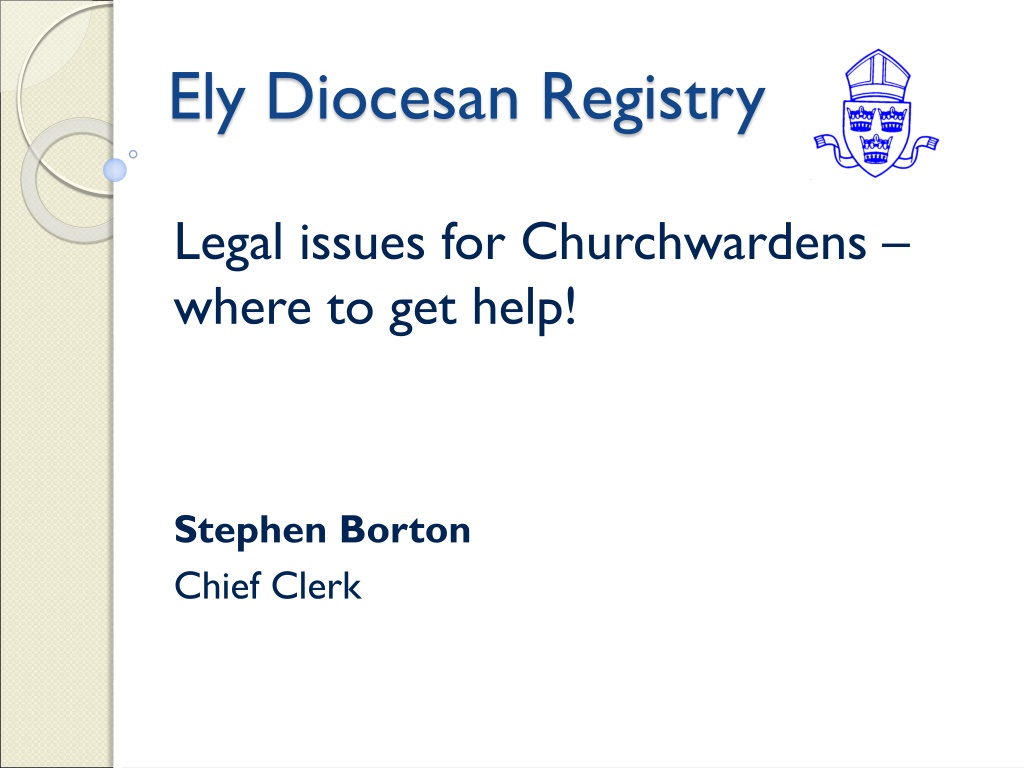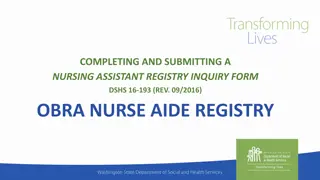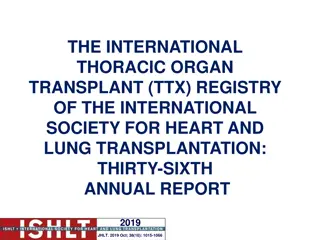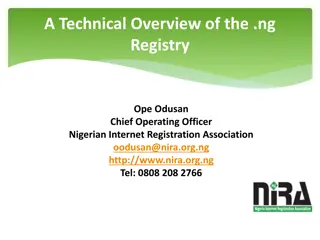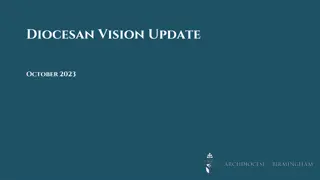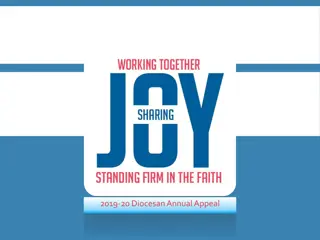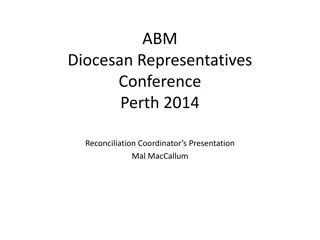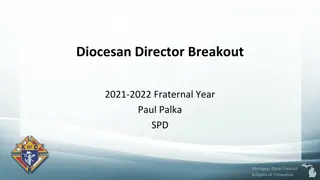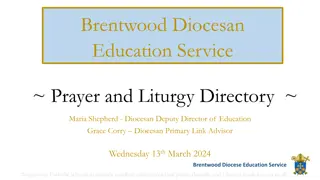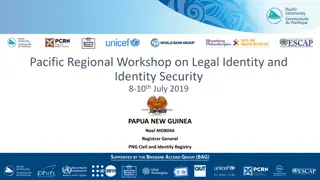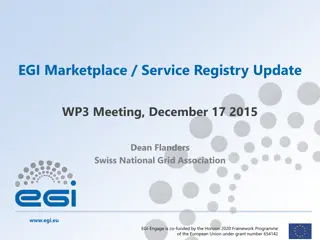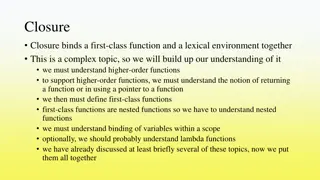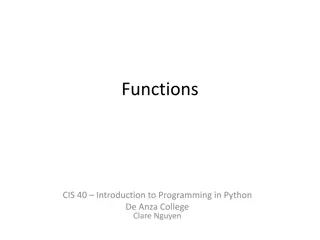Ely Diocesan Registry and Its Functions
The Ely Diocesan Registry plays a crucial role in handling legal matters for Churchwardens. It is responsible for processing petitions, issuing documentation, providing legal advice, and maintaining various records related to the Church of England. Through its operations, the Registry supports clergy, parish officers, and the general public in navigating a range of church legal issues.
Download Presentation

Please find below an Image/Link to download the presentation.
The content on the website is provided AS IS for your information and personal use only. It may not be sold, licensed, or shared on other websites without obtaining consent from the author. Download presentation by click this link. If you encounter any issues during the download, it is possible that the publisher has removed the file from their server.
E N D
Presentation Transcript
Ely Diocesan Registry Legal issues for Churchwardens where to get help! Stephen Borton Chief Clerk
WHAT IS THE DIOCESAN REGISTRY AND WHAT DOES IT DO?
What is the Diocesan Registry? Each Diocese of the Church of England has two Legal Officers, the Chancellor and the Registrar (both of whom may have deputies). Howard Dellar is the Diocesan Registrar Michael Fletcher and Catherine Shelley are Deputy Registrars Susan Black is a Clerk in the Registry and initial point of contact for the day-to-day work of the Registry Also: 4 other Diocesan Registries at 1 The Sanctuary Faculty Office of the Archbishop of Canterbury LBMW Solicitors: not just EEC Department, but wide range of legal practice and expertise available to Registry (including: Charity Law; Property & Trusts; Employment & Contracts; Regulatory Law incl. Data Protection; Education Law incl. academies & schools; Safeguarding; Private Client incl. Wills/probate/conveyancing
What does the Diocesan Registry do? (1) processing Petitions for Faculties; issuing to the Bishops/Archdeacons the documentation appointing clergy (and certain lay persons) to their posts; dealing with enquiries from clergy, parish officers and the general public on matters to do with baptism, burial, marriages, and a range of other church legal issues; maintaining a variety of diocesan records
What does the Diocesan Registry do? (2) issuing the documentation to enable burial grounds to be consecrated; issuing Common Marriage Licences; maintaining the Patronage Register and other linked functions; giving free retainer legal advice to parish officers, clergy, diocesan officials, boards and committees of the diocese.
When to contact Diocesan Office Initial enquiries for faculties (the DAC) Parish property Vacancies in benefices Communications and media handling Pastoral (parish) reorganisation Safeguarding of children and vulnerable adults (NB the Registry will also assist with safeguarding matters. It is responsible for advising the Bishop regarding clergy discipline/suspensions and the new provisions relating to lay officer suspension/barring on safeguarding matters)
WHAT ARE THE LEGAL DUTIES AND RESPONSIBILITIES OF CHURCHWARDENS?
This CartoonChurch.com cartoon by Dave Walker originally appeared in the Church Times
Duties of a Churchwarden (1) Canon E1(4) Officers of the Bishop Foremost in representing the laity and in co- operating with the Incumbent By example and precept, encourage parishioners in practice of true religion Promote unity and peace amongst parishioners Maintain order and decency in the church and churchyard
Duties of a Churchwarden (2) Maintain order and decency Canon F15 Duty to ensure no disturbance during divine service Restrain anyone guilty of riotous, violent or indecent behaviour or disturbing, vexing, troubling or misusing any minister officiating Criminal offence to strike anyone in church or churchyard Any person offending may be arrested by a constable or churchwarden of the parish (Ecclesiastical Courts Jurisdiction Act 1860)
HEALTH WARNING!! The Registrar s retainer does not include defending Churchwardens against assault or unlawful imprisonment charges!! CALL THE POLICE!
Duties of a Churchwarden (3) Canon E1(5) Vested of the property in the plate, ornaments and other movable goods of the church (but you can t sell it!!) Must keep an inventory of them up to date Deliver such goods to their successor N.B. As Churchwarden, and hence ex officio on the PCC, responsibility for financial affairs of parish (thus disqualification under Charities Act)
Duties of a Churchwarden (4) Canon B17(1 and 2): The churchwardens of every parish, with the advice and direction of the minister, shall provide a sufficient quantity of bread and wine for the number of communicants that shall from time to time receive the same. The bread, whether leavened or unleavened, shall be of the best and purest wheat flour that conveniently may be gotten, and the wine the fermented juice of the grape, good and wholesome.
Duties of a Churchwarden (5) Canon F13(3) It shall be the duty of the minister and churchwardens, if any alterations, additions, removals, or repairs are proposed to be made in the fabric ornaments or furniture of the church, to obtain the faculty or licence of the Ordinary (the Bishop) before proceeding to execute the same Thus incumbent and churchwardens are normally the petitioners for a faculty
Duties of a Churchwarden (6) Canon F13(4) To maintain records: The Logbook records everything done to the church (alterations, additions, repairs) The Terrier records all property or land owned by the PCC (halls, curates houses etc) The Inventory a record of all movables in the church (vestments, altar frontals, plate, ornaments, furniture etc: i.e. What the churchwardens own ) Terrier and Inventory comprise Church Property Register
Duties of a Churchwarden (7) Annual inspection of fabric/articles and annual fabric report to PCC and then APCM Logbook, Terrier and Inventory should be produced to PCC annually and signed off
Who helps? Incumbent and other clergy PCC officers (Chair, Secretary and Treasurer) and other PCC members Deputy Churchwardens (limited delegation) Assistant Churchwardens (can only assist) Sidesmen: appointed by APCM or PCC (must be electoral roll members).
PCCs (1) Ex officio PCC members (i.e. Charity trustees) and PCC Standing Committee PCC has responsibility for: conduct of the financial affairs of the parish (accounting, budgeting etc) care, maintenance and insurance of the church and its contents care and maintenance of the churchyard worship and mission of the parish role in appointment of parish priest role in synodical government of the Church
PCCs (2) PCCs are charities with two Governing Documents : Parochial Church Councils (Powers) Measure 1956 Synodical Government Measure 1969 (in particular the Church Representation Rules 2011) Both available on the internet PCC must have a Standing Committee of at least 5 Minister plus Churchwardens are ex- officio. There must be a secretary and treasurer
THE FACULTY JURISDICTION: WHAT IS A FACULTY AND HOW IS A FACULTY APPLIED FOR?
Faculty Jurisdiction (1) Section 1 of the Care of Churches & Ecclesiastical Jurisdiction Measure 1991: Any person or body carrying out functions of care and conservation under this Measure or any other enactment or rule of law relating to churches shall have due regard to the role of a church as a local centre of worship and mission A large proportion of the built heritage of this country listed at Grade I or Grade II* belongs to the Church of England and are places of worship in use as such.
Faculty Jurisdiction (2) Threefold aim of ensuring churches: Retain their historical importance Are fit for purpose in the present Are an appropriate legacy to be handed on to future generations Ecclesiastical Exemption: no Listed Building Consent required.
Faculty Jurisdiction (3) Parish priest, churchwardens, PCC members are trustees during their term of office. A balancing act between past, present and future. Church does not belong to any one generation. But have regard to purpose as local centre of worship and mission
List of matters not requiring a faculty (Lists A & B): from Jan 2016 List A: matters which may be undertaken without the need for consultation List B: matters which may be undertaken subject to consultation etc Archdeacon must give notice in writing that the work may be carried out without faculty
List A The minister/churchwardens or other PCC representatives can go ahead with works in List A without diocesan permission BUT the specified condition(s) in relation to each category of work must be adhered to, e.g.: Notify PCC insurers if external scaffolding erected Accredited/registered contractors must be used for gas fitting works or electrical installation/equipment
Examples of List A matters (no consultation required) Repair & routine maintenance of building not affecting the fabric Like-for-like repair to non-historic clear window glass Repairs/ replacement mesh window guards Repair/ routine maintenance of heating systems, gas/ water/ electrical installations Introduction of musical instruments (excluding organs/ grand pianos) Repair & routine maintenance of bells/ bell stays/ bell ropes Repair of woodwork, metalwork and movables Introduction/removal of kneelers, bookcases, books, free-standing notice boards, display stands, hymn boards, altar linen (not frontals) Repair & maintenance of churchyard paths using same materials Repair/ maintenance/ like-for-like replacement of fences & gates Repair/ repainting a notice board Felling, lopping, topping of a tree where the trunk is <75 mm (3``) diameter at a height of 1.5m (5`) Lopping, topping of any tree that is dying/dead/dangerous Removal of dead branches from a living tree (TPO/Cons.Area)
List B Consult with Archdeacon / DAC office Many List B items previously needed a faculty The faculty petition can now be avoided, but consultation with Archdeacon (and potentially DAC) is required Each description of a type of work (a matter ) may have specified conditions
List B (contd) Archdeacon must given written consent Specified (i.e. Standard) conditions must be adhered to Archdeacon may impose additional conditions Before giving written consent, Archdeacon must seek advice of DAC (either full committee or individual members/officers) Copy of Archdeacon s notice must be stored by Archdeacon, DAC Secretary and Diocesan Registry
Examples of List B matters (consultation with the Archdeacon) Repair & routine maintenance of the fabric of building identified in QI report External/internal redecoration (other than to areas of historic wall painting) Timber treatment Minor adaption heating systems, gas/ water/ electrical installations Replacement boiler Like-for-like replacement roofing Installation of lighting Installation of sound/loop system Repair & maintenance of church plate (incl. candlesticks & crosses) Introduction of portable AV equipment Replacement of carpets Introduction of book of remembrance Introduction of fixed internal notice board Introduction of churchyard bench Routine maintenance of churchyard walls Planting of trees Felling of any tree that is dying/dead/dangerous
Archdeacons Licences for Temporary Reordering Temporary minor re-ordering Period cannot exceed 15 months Licence cannot be granted if parish has no minister (incumbent/priest-in-charge/team vicar) Archdeacon must first seek DAC advice The scheme must be wholly reversible There must be: No material interference with or alteration to fabric No electrical works No disposal of any fixture or article Any article which is moved must be stored safely and easily reinstated
When is a faculty still required? If the Chancellor has made an Order regarding a specific parish, church, churchyard or other building or place, which excludes the use of Lists A & B To be used if the system is being abused (i.e. punitive) and for any building which requires special treatment (e.g. of special artistic importance)
When is a faculty still required? Where the architectural/historic character of a building, or archaeology, would be affected Where Schedule Monument Consent is required Where a building is to be extended or demolished or partially demolished Where human remains are disturbed For the introduction of an aumbry or other receptacle used for reservation of Holy Communion
This CartoonChurch.com cartoon by Dave Walker originally appeared in the Church Times
Faculty Application (1) Making Plans Consultation Resolution Statement of Need and Significance DAC Consultation Further Consultations Petition Public Notice Decision
Faculty Application (2) Making Plans PCC has responsibility for the care and maintenance of the church & churchyard PCC may decide that it is time to make a repair or alteration, BUT (if not on List A/B) The Chancellor has final control over the church, contents and land on behalf of Bishop So, PCC does not decide what it WILL do, but rather what it will seek PERMISSION to do
Faculty Application (3) DAC starts off the faculty application process DAC = Diocesan Advisory Committee for the Care of Churches Committee of experts, to advise parishes, as well as the Archdeacons and Chancellor Architects, clergy, Archdeacons (ex officio), specialists e.g. Organs, bells, heating, archaeology Issue a DAC Notification of Advice: recommend / no objection / not recommend May be provisos to their decision Advises who should be formally consulted
This CartoonChurch.com cartoon by Dave Walker originally appeared in the Church Times
Faculty Application (4) So what does this mean? DAC assist at outset of project and give advice DAC involvement ends with issuing of Notification of Advice: recommend, decline, or no objection . Chancellor takes this into account. Chancellor decision-maker; therefore when DAC stage completed all the papers, including the formal petition, are put to him for his decision. Registry then keeps file.
Faculty Application (5) Consulting Important to consult widely amongst congregation and other interested persons Architect, Archdeacon, DAC Resolution The PCC requests the minister and churchwardens to apply for a faculty to do such and such a piece of work according to the specification supplied by X
Faculty Application (6) Statement of Need Why is it important to the church undertake the work? How will it assist its mission? Statement of Significance What is the impact of the work on the church as a place of special architectural or historic importance? Refer to Church Buildings Council guidance and www.statementsofsignificance.org.uk
Faculty Application (7) Further Consultation Historic England Church Buildings Council Local Planning Authority (but nb Ecclesiastical Exemption) Amenity Societies: The Ancient Monuments Society (before 1715) The Society for the Protection of Ancient Buildings (up to 1714) The Georgian Group (1700-1840) The Victorian Society (1847-1914) The Twentieth Century Society (1914 onwards)
Faculty Application (8) The Petition (Forms 1A and 3A), plus: DAC Notification of Advice Public Notice PCC Resolution Insurance Approval Statement of Need/Statement of Significance Proposals/Specification/Quotes/Photos/Plans Send to The Diocesan Registry, 1 The Sanctuary, Westminster, London SW1P 3JT No need to wait until the public notice expires (especially for non-contentious applications) but do forward on Certificate of Publication
Faculty Application (9) The Public Notice Displayed for 28 days (not including the day on which it is put up or taken down) Notice board inside the church AND Outside the church where it is readily visible to the public Gives detail as to where plans may be inspected and how to comment or object And ... Notice posted on diocesan website (21 days) for major projects
Faculty Application (10) The Decision Chancellor can decide: To grant the faculty To request further information To refuse the faculty (whether or not there have been objections) Once granted the works can be implemented Certificate of Practical Completion Copy in Parish Records Return to the Registrar (with copy to Archdeacon)
Faculty Application (11) Can we appeal? Yes, an appeal exists to the Court of the Arches against a refusal or the grant of a faculty An application must be on a point of law and with the consent of the Chancellor or the Court of the Arches Time limit is 28 days from the date of the judgment Presided over by the Dean of the Arches and two other Diocesan Chancellors
What happens when... Someone objects? Anyone with an interest can object Parishioners or those on the church electoral roll The local planning authority Historic England (previously English Heritage) National Amenity Societies (e.g. Victorian Society) Chancellor decides whether to grant or not: By negotiating an agreement; By written representations; or At a full Consistory Court hearing Parish may need to pay legal Court costs
What happens when... We forget to apply for a faculty? Archdeacon can apply for a restitution order Apply for a retrospective confirmatory faculty Petition Fee / Court costs may be payable by the parish Wardens incur legal costs after unauthorised sale St Ebbe s with Holy Trinity, Oxford Chancellor lambasts really stupid sale of painting Emmanuel Church, Leckhampton
What happens when... There is an emergency? The Chancellor may give permission (an Interim Faculty) for works to proceed to protect the church with a full faculty application to follow. NOTE: a builder turning up to do works for which you have forgotten to apply for a faculty is NOT an emergency!! damage caused by wind, flooding or vandals MAY be an emergency. BUT you need to contact the Archdeacon in the first instance and discuss it with him.
What happens when... We need to make changes as building work progresses? The faculty will set out precisely what has been permitted Minor changes can often be agreed with an addendum to the faculty More substantial alterations may result in a requirement for further consultation
Other matters requiring Faculties include: Confirmation of Archdeacon s Licence, or Interim Faculty Demolition (or partial demolition) Extensions or new buildings Introduction or sale of certain church goods: Vestments, altar frontals etc Items of historic value/ importance Felling of a healthy tree in churchyard Private Faculties: Erection of Memorial in a churchyard Gravespace reservation Exhumation/ re-interment
